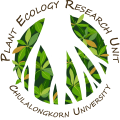Photosynthesis and some related factors of red mangrove Rhizophora mucronata Poir. At Tungka-Sawi Bay, Chumphon Province
Name: Suthathip Umnouysin
Co-supervisor: Sasitorn Poungparn
Abstract
The photosynthesis of R. mucronata study was conducted in four stand ages (1, 3, 5 and 9 years old) during rainy and dry seasons at Tungka-Sawi Bay, Chumphon Province. Light response curves of R. mucronata were established. Maximum photosynthetic rate, stomatal conductance (g[subscript s]), intercellular CO2 concentration (Ci) and transpiration rate (Tr) were measured. Then, water use efficiency was calculated. Furthermore, some factors that related to the photosynthesis, including specific leaf area (SLA), nitrogen content (N), sodium ion (Na+), chloride ion (Cl-) in leaf, leaf anatomy and environmental factors (i.e., physical and chemical properties of water and soil) were examined. The results of light response curve showed that quantum yield and light saturation point of all stands were not different between rainy and dry season. Nevertheless, light compensation point and respiration rate in the dry season were higher than those in the rainy season according to the high air temperature and soil water salinity in the dry season. The maximum photosynthetic rates of all stands were lower in the dry season than those in the rainy season. In dry season, the soil water salinity increases, resulting in reduction of gs, Ci, Tr, leaf N and thickness of mesophyll layer but increasing Cl- concentration in leaves. Correlation analysis indicated that there was a significant correlation between the maximum photosynthetic rates of R. mucronata and related factors in each stand. The factors that had the most correlation with the photosynthesis of most stand were gs, leaf N and soil water salinity.
